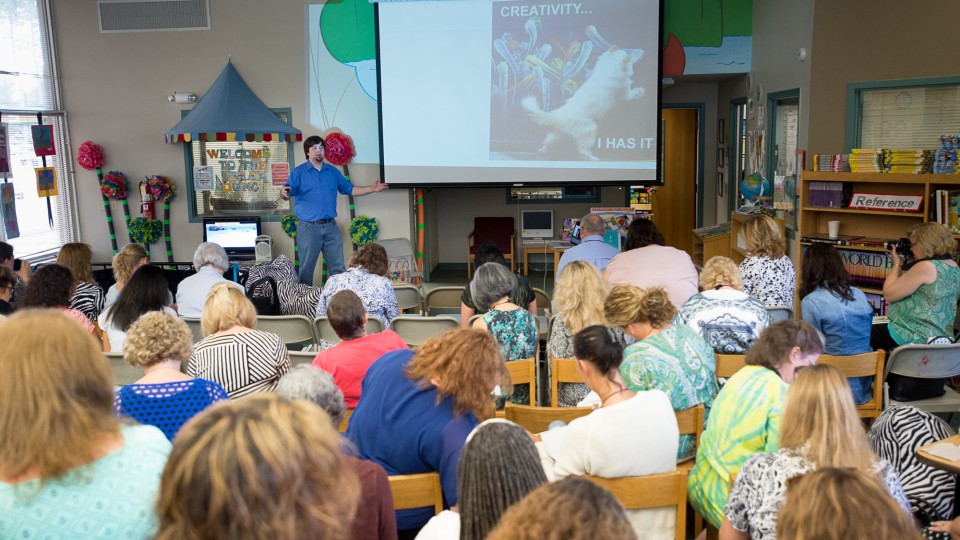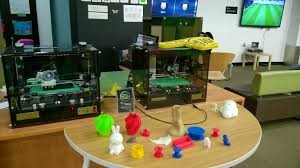Making space for creativity in Escambia schools
- August 14, 2015
- / Reggie Dogan
- / education

Brian Richman, Director of Strategic Innovation with the Evolve Project speaks to Escambia County School media specialists at Pine Meadow Elementary School Tuesday, August 11, 2015. (Michael Spooneybarger/ Studer Community Institute)
When Escambia County students return to school on Aug. 17, they will find their old libraries, now called media centers, transformed into 21st century innovation centers.
Inside of them will be Makerspaces, the latest step in the transformation of libraries into creative zones for interactive learning.
A Makerspace is a workplace playground where students gather to create, invent, tinker, explore and discover using a variety of tools and materials.
Makerspaces encourage experimentation, open-ended exploration and the belief that making mistakes is a positive way to learn, said Brian Pichman, director of Chicago-based Strategic Innovation Evolve Project.
“Children like to build things, they like to tinker and they like to play,” Pichman said. “Makerspaces are gateways to new ideas that spark interest in fields such as engineering, computer programming and business.”
Pichman was in Pensacola on Tuesday, Aug. 11, to introduce Makerspaces and provide training to about a hundred media specialists and staff at Pine Meadow Elementary School.
Escambia schools Superintendent made the Makerspace movement among his top initiatives in his Vision 2020 plan.
“We’re going to shake it up. This is about putting teachers in charge and empowering them to lead the way to engage students,” Thomas said. “That is absolutely the key to learning.”
Engagement is a key component of the Makerspace model. In theory and practice, a Makerspace provides creative time and space for students to build prototypes, explore questions, fail and retry, bounce ideas off one another and create things together.
Spark creativity
The beauty of the Makerspace movement is that there is no set list of equipment or programming required to make a space successful. While every school can have its own Makerspace, no two will be exactly alike.
“Last time I checked, one-size T-shirt doesn’t fit everybody,” Thomas said. “The same way with learning. Even a single Makerspace is adaptable to all learning strengths and styles for every kid.”
While 3-D printers are perhaps the signature offering of Makerspaces, libraries find that low-tech and low-cost opportunities are just as popular.
The spaces don’t always include high-tech gizmos or expensive tools, since some designs can be built out of materials as simple as paper towel rolls or plastic Solo cups.
One school could have an area to build Legos and a three-dimensional model with Sketchup, while another uses snap circuit kits and Play-Doh.
The list of equipment and materials will naturally grow as specific projects and programs generate new needs. For example, a Makerspace experience might be based on costume-making that would require sewing machines, whereas a graphic design workshop would benefit from access to a vinyl cutter.
Students can also use various types of materials and tools as inspiration to create projects to share their learning for Genius Hour and project-based learning, Pichman said.
Deborah Dorough, Pine Meadow Elementary School media specialist, found out about Makerspace before she heard it would become a part of the district’s Vision 2020 plan.
She began last year gathering information and ideas on how to implement Makerspaces from online websites like Pinterest and YouTube.
Dorough used her research to create a Makerspace for Pine Meadow’s innovative center.
Dorough simply mounted an oil drip pan from Wal-Mart inside a wooden cabinet. She then struck magnets on the back of plastic marble runs to create a fun learning tool for children to help develop skills in math, physics and construction.
“Makerspaces spark creativity and helps children understand that it’s OK to play,” Dorough said. “It’s OK to have some fun and learn at the same time.”
Working together
Makerspaces promote learning through play. They have the potential to demystify science, math, technology and engineering.
During the session at Pine Meadow, attendees put on their creative caps and assembled in groups at tables to see how Makerspaces work.
One group worked on a “Light Up Edison Kit,” a circuit-building exercise that showed how electronics work and how to build things in seconds.
Hazel McCormick, Woodham Middle School media specialist, joined a group that tried out the Tiggly Shapes Learning System. Using iPads and tablets, they spelled words, made shapes and solved math problems like preschool to fourth-graders would.
McCormick believes the creative space will attract students to libraries and encourage them to work together to solve problems.
“Asking kids to think creatively builds on their knowledge,” she said. “Students will be teaching students, and I think it’s awesome.”
One big concern media specialists have is how their schools will find money and resources to buy equipment and to supply materials for Makerspaces?
“The biggest obstacle is getting money to get tools and equipment,” McCormick said. “Ideas and creativity are there, but it’s a cost thing.”
Sheila Brandt, Escambia schools coordinator of media services, said while funding is a concern, schools can develop community partnerships, find grants and seek donations to help defer costs.
Superintendent Thomas doesn’t see money as a hindrance to creativity. The district already is buying chrome books for third- to 12-graders, using money the state provides for technology. And the cost of computers has fallen so they now can buy replacements at a cost of two for one, he said.
Schools also should take advantage of low-cost alternatives like Pine Meadow did to build a Makerspace.
“Most of Makerspaces don’t cost money,” he said. “If you go look at that Pinterest site that’s been set up, they’re using empty paper towel holders.”
Creating playful information-based spaces allows the student to explore and engage with content on his terms instead of the teacher’s terms.
The library, as a gathering spot for people and storage house for knowledge, is the perfect place for Makerspace, Richman said.
“I like the analogy that libraries used to be like a grocery store where they provided things, but now they’re like kitchens where you can make things,” Richman said. “Libraries are about providing access. What if your library helped launch the next superstar in the tech field?”


 CivicCon launches with a look at good growth in cities
CivicCon launches with a look at good growth in cities
 Building stronger brains one baby, one parent at a time
Building stronger brains one baby, one parent at a time
 SCI debuts commercial on Early Learning City
SCI debuts commercial on Early Learning City
 Entrecon: World class speakers and an opportunity to sharpen skills
Entrecon: World class speakers and an opportunity to sharpen skills
 PYP Quality of Life survey 2017
PYP Quality of Life survey 2017
 EntreCon Pensacola 2016: A look back
EntreCon Pensacola 2016: A look back
 Leadership tip: getting better employee takeaways
Leadership tip: getting better employee takeaways
 Leadership tip: be interested instead of interesting
Leadership tip: be interested instead of interesting
 Leadership tip: delivering difficult messages
Leadership tip: delivering difficult messages
 Brain Bags boost Arc, Early Childhood Court programs
Brain Bags boost Arc, Early Childhood Court programs